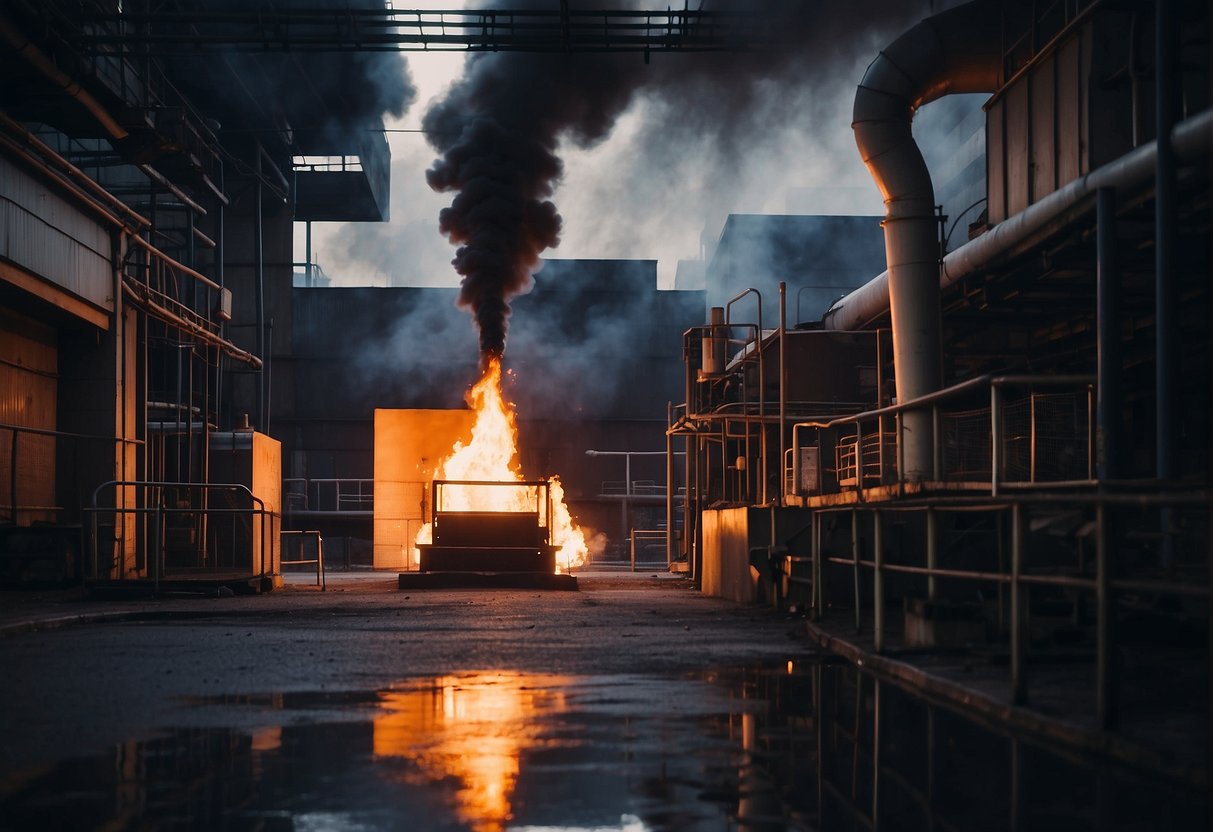As blockchain technologies evolve, various methods are employed to maintain the health and efficiency of the networks. One practice within the Solana ecosystem is the burning of tokens, which is where the Sol Incinerator comes into play. It is a specialized platform designed for the safe and deliberate removal of unwanted tokens from circulation.
Using the Sol Incinerator, you can effectively reduce the token supply of certain cryptocurrencies. This can be for various reasons such as to control inflation, reward token holders, or clean up the blockchain from unused or redundant assets. The impact of token burning on the Solana network is substantial, enhancing its performance and potentially strengthening the value of the remaining tokens. Further, the process is managed with a fee structure that takes a small amount of SOL for the service provided, with specific rates for different types of assets, including NFTs.
Understanding the significance of token burns and their intricate workings is vital for anyone involved in or considering interaction with the decentralized finance (DeFi) space. It has important implications for the overall token economy, the functionalities of DeFi platforms, and the long-term strategies of blockchain projects. Security is paramount when participating in these processes, ensuring that the incineration of assets is intentional and irreversible.
Key Takeaways
- Sol Incinerator aids in managing the Solana ecosystem by allowing users to remove unwanted tokens.
- The process carries importance for network health, potentially influences token value, and incurs small fees.
- Engagement with token burning mechanisms mandates a high level of security awareness and intentionality.
Overview of Sol Incinerator
Sol Incinerator provides a specialized service on the Solana blockchain. It serves a specific function – to burn unwanted or unnecessary tokens, effectively removing them from circulation. When you choose to use Sol Incinerator, you take full responsibility for the tokens burned.
Your decision to use the platform should be informed by the understanding that once the tokens are burned, they cannot be recovered. It’s equivalent to permanently deleting files from your computer; they’re gone for good.
In terms of energy consumption, the Solana blockchain is known for its efficiency and low power usage compared to traditional proof-of-work blockchains. This characteristic extends to the services running on its network, including Sol Incinerator. As a result, you partake in a more environment-friendly method of token management compared to other energy-intensive platforms.
Regarding the environment, the use of solar power is a progressive step in minimizing the carbon footprint of blockchain operations. The conceptual alignment with solar energy highlights the direction towards sustainable and responsible crypto-related activities.
It is crucial to appraise any service’s impact on the environment, and Sol Incinerator provides a solution that resonates with a growing consciousness around sustainable digital finance. By choosing to manage your digital assets through such platforms, you contribute to a healthier ecosystem—both virtual and real.
Remember, using Sol Incinerator means acting responsibly with your digital assets while potentially contributing to a greener blockchain environment.
Functionality of SOL Incinerator
The SOL Incinerator is a dedicated mechanism on the Solana blockchain for the burning of tokens. It facilitates a decrease in token supply by permanently removing tokens from circulation, which can have implications for token value and blockchain efficiency.
Token Burning Process
When you choose to burn tokens, you engage in a procedure that completely removes those tokens from existence. This process is irreversible, meaning once tokens are burned, they are out of circulation forever. Here’s how it typically works:
- Select Tokens: You select the tokens you wish to burn.
- Send Tokens: You send these tokens to a specific address that represents the SOL Incinerator.
- Confirmation: The incineration is verified and completed, effectively reducing the total supply of the token in question.
This process is executed on the blockchain, ensuring transparency and immutability.
Smart Contract Integration
Smart contracts play a pivotal role in the SOL Incinerator’s functionality. They automate the burning process and ensure that it occurs without any human intervention once the conditions are met.
- Automated Process: The smart contract contains the logic that executes the burn.
- Security: All interactions are secure and governed by the smart contract code, which has been publicly audited and verified.
Through smart contract integration, SOL Incinerator creates a trustless environment for token burning, where your assets are managed according to the encoded rules and executed precisely as intended.
Interacting with SOL Incinerator
To engage effectively with the SOL Incinerator, you’ll need a compatible wallet interface and an understanding of how to confirm transactions safely and accurately.
Using Wallet Interfaces
When you decide to use SOL Incinerator, the first step is to select and connect a compatible wallet. Options like Phantom and Solflare are widely accepted. Ensure your selected wallet has the tokens you wish to burn. Once you’ve made your choice, you’ll typically see a button or link prompting you to ‘Connect Wallet.’ Click this, and follow the prompts to authorize the connection.
- Steps to connect your wallet:
- Visit the SOL Incinerator website.
- Click on ‘Connect Wallet’.
- Choose your wallet provider (e.g., Phantom, Solflare).
- Follow the authentication steps provided by your wallet.
Confirming Transactions
After connecting your wallet, you’re ready to perform the burn transaction. Before confirming the transaction, it’s essential to double-check the details. Make sure you are only burning tokens you intend to dispose of permanently. Transactions on the blockchain are irreversible.
- Key things to check before confirming a transaction:
- Token details and quantities to burn
- Wallet address verification
- Network fees and total cost
After reviewing, press the ‘Confirm’ button within your wallet interface to initiate the token burn. If using Phantom or Solflare, you’ll likely receive a pop-up to confirm the transaction. Watch for confirmation notifications to ensure the process has completed successfully.
Impact on Solana Ecosystem
The Sol Incinerator enhances the robustness of the Solana ecosystem by addressing issues like unnecessary transaction costs and the presence of undesirable tokens. Your experience with the Solana blockchain is poised to improve with this tool’s influence.
Reducing Solana Transaction Costs
Solana transaction costs, though already lower than many competing blockchains, can be further reduced by using the Sol Incinerator. This tool eliminates the need to maintain accounts for redundant tokens, which can incur costs over time. By burning and closing accounts with the Sol Incinerator, you can reclaim Solana fees that would otherwise be wasteful to hold on to.
Cleaning Dust and Scam Tokens
The presence of dust (small amounts of tokens) and scam tokens can clutter and compromise your Solana wallet’s integrity. The Sol Incinerator serves to alleviate your wallet from these unwanted assets, effectively simplifying your portfolio and enhancing security. It is particularly useful in the maintenance of a clean and organized wallet, offering a structured way to remove these nuisances.
The Economics of Burning Tokens
When you engage in the process of burning tokens on the Solana blockchain, you’re embarking on a financially strategic move that has specific costs and benefits. It’s critical to understand how transaction fees figure into this activity, as well as the concept of rent exemption and how it plays into the possibility of reclaiming SOL.
Transaction Fees and Associated Costs
Whenever you conduct a transaction to burn tokens on the Solana blockchain, you’re required to pay transaction fees. These fees are necessary to compensate for the computational energy required to process and validate transactions. It’s essential to note that these fees are incurred regardless of the number of tokens you’re looking to incinerate. Consequently, if your strategy is to send small amounts of tokens individually, this could become cost-ineffective because the fees for creating new token accounts could outweigh the benefits of burning them.
Rent Exemption and Reclamation
The Solana network employs a rent exemption feature that allows token accounts to be rent-exempt if they hold a minimum balance. This system incentivizes users to maintain tidy account states, thus ensuring efficient use of space on the blockchain. When you burn tokens, you may be able to reclaim some of the SOL deposited for rent exemption by closing the account associated with the tokens. The amount of SOL reclaimed remains constant, irrespective of the quantity of tokens that the account holds.
Keep these financial aspects in mind as they can impact your decisions and the overall efficiency of your token management on the Solana blockchain.
Particularities of NFTs on Solana
In the dynamic ecosystem of Solana, NFTs hold a distinctive place. They offer both opportunities and challenges, especially when it comes to managing unwanted digital assets.
Dealing with Unwanted NFTs
If you find yourself with unwanted NFTs in your Solana wallet, the process for handling them is uniquely efficient. The Sol Incinerator service empowers you to clean up your wallet by safely burning these NFTs. When you decide to burn your NFTs, you essentially remove them from circulation. This can be a powerful tool to rid yourself of spam or fraudulent tokens that may clutter your wallet.
It’s crucial for you to acknowledge that once burnt, an NFT cannot be recovered; it’s permanently deleted from the blockchain. Some platforms may incentive this process by offering a small amount of SOL in return, though the amount could vary based on the specific token or NFT involved. Always ensure to triple-check any actions with your NFTs on Solana to prevent accidental loss of value.
Security Considerations
When evaluating the security of the Sol Incinerator, it’s imperative to understand the robustness of the platform’s smart contracts. These contracts execute the destruction of tokens or NFTs and the integrity of your assets hinges on their reliability.
Smart Contract Audits
Your confidence in the Sol Incinerator stems from the thorough audits conducted on its smart contracts. Audits are critical as they help to identify and rectify potential security vulnerabilities. Here’s what you need to know:
- Audit Frequency: Regular audits ensure that the smart contracts you rely on for burning tokens are up to date with the latest security practices.
- Audit Results: Audit findings should be transparent, allowing you to verify the safety measures put in place to protect your digital assets.
It’s crucial for you to review these audits as they reflect the ongoing commitment to security and trustworthiness of the platform.
Decentralized Finance (DeFi) and Token Burn
In the dynamic world of DeFi, the processes of burning and minting tokens are fundamental mechanisms impacting your assets’ value and scarcity. These actions are pivotal in sustaining a healthy economic model.
DeFi Token Lifecycle
Burning tokens, often referred to as “token burn,” is a deliberate action where you permanently remove tokens from circulation. This process is facilitated by sending tokens to a wallet address that is unspendable, effectively reducing the available supply. Engaging in a token burn, you sometimes directly influence the scarcity and potential value of the remaining tokens in a DeFi ecosystem.
Minting represents the creation of new tokens. Unlike fiat currencies, where central authorities control minting, in DeFi, smart contracts typically govern when and how tokens are minted. This process can be tied to various mechanisms, such as staking rewards or liquidity mining.
– Burning:
- Purpose: Enhance token scarcity, potentially increase value
- How it Happens: Send to an unreachable address, contract function call
- DeFi Impact: Deflationary pressure, governance decisions
– Minting:
- Purpose: Reward users, introduce new tokens
- How it Happens: Smart contract execution
- DeFi Impact: Inflationary pressure, ecosystem growth
Both burning and minting are actions that you, as a participant in the DeFi space, may encounter. Understanding their roles and effects on token economics is crucial for making informed decisions in your DeFi interactions.
Advanced Features
When leveraging the Sol Incinerator, you gain access to robust tools tailored for efficient management of your digital assets on the Solana blockchain.
Support for Multiple Tokens
Sol Incinerator allows you to seamlessly handle multiple Solana tokens for burning. You can streamline the decluttering of your wallet by eliminating various tokens, such as unwanted NFTs or scam tokens.
- Burn NFTs: Receive up to 0.01 SOL back for most NFTs.
- Dispose of Tokens: Get up to 0.002 SOL for the majority of tokens.
- Special Cases: For items minted with specific protocols, a higher return of 0.004 SOL may apply.
By utilizing this feature, you can recover Solana fees previously incurred from storage space these assets occupied. Visit the Sol Incinerator for more details on this functionality.
Environmental and Energy Insights
As you consider the impact of solar incinerators, understand that they represent a significant shift in waste management and energy production. Your need to balance environmental concerns with energy needs is met with innovative solutions that solar incineration offers.
Comparison to Traditional Methods
Solar incinerators are a modern approach aimed at reducing energy consumption and minimizing the environmental footprint of waste management. Here’s how they stack up against traditional incineration methods:
- Energy Efficiency: Traditional methods often rely on fossil fuels, leading to higher energy costs and a larger carbon footprint. In contrast, solar-powered incinerators harness the sun’s energy, thus reducing reliance on non-renewable energy sources and optimizing energy use.
- Emissions: Solar incineration techniques can lead to lower emissions. The integration of solar technology in waste-to-energy processes has the potential to reduce pollutants significantly as compared to conventional incineration, which can emit various harmful gases.
- Waste Reduction: Both methods effectively reduce the volume of waste, but solar incinerators offer an eco-friendlier pathway by leveraging renewable energy.
- Cost Implications: Initial investment in solar incineration technology may be higher; however, the long-term operational costs could be less due to the free and abundant nature of solar energy.
By adopting solar incineration, you not only contribute to a more sustainable future but also embrace a system that is designed to be more harmonious with the environment.
Future of Token Burning
The landscape of blockchain technology is continually evolving, and within this space, the process of token burning stands to see significant advancements. Your understanding of these changes is crucial as they can have tangible impacts on how you manage digital assets.
Prospective Developments
Token Burning API: One of the most anticipated updates in the realm of token burning is the release of an API by Sol Incinerator. This feature will allow other projects to integrate Sol Incinerator data, simplifying the burn process and potentially bringing more efficiency and security.
Advantages:
- Efficiency: Streamlining token burns will save you time and enhance your experience by doing so directly through third-party platforms.
- Innovation: As the Sol Incinerator API integrates with more services, you can expect a surge in creative ways to manage and burn tokens.
The inclusion of solar-powered technology in token burning mechanisms, like the Sol Incinerator, is another innovative push, presenting an environmentally-friendly solution to managing the digital ecosystem. Your contribution to sustainability is increased by opting for platforms that use renewable energy sources for token burning activities.
In conclusion, keep a close watch on these developments as they are poised to redefine how you interact with token burning and sustainability in blockchain technology.
Frequently Asked Questions
Before diving into the specifics, it’s essential for you to understand the intricacies of how a Sol Incinerator operates and the impact it has on the digital asset it targets. These subsections aim to clarify some of the common uncertainties regarding digital asset incineration.
What are the safety protocols for operating an incinerator designed for digital assets?
While digital asset incinerators do not pose physical hazards, safety here refers to cybersecurity. Your use of a Sol Incinerator should adhere to best practices like ensuring the platform’s integrity, double-checking the assets you wish to burn, and understanding the finality of the incineration process.
What are some alternative methods to a digital asset incinerator for reducing supply?
Other methods to reduce the supply of digital assets include token buybacks followed by a burn, or using smart contracts to lock tokens for a set period, therefore, reducing circulating supply.
How does burning digital assets differ from incinerating them?
Burning digital assets typically refers to the removal of tokens from circulation effectively, while incinerating them often involves a specific mechanism or platform, such as an incinerator tool, where digital assets can be destroyed in a more formal or systematic way.
Can you explain the mechanism behind incinerators used for cryptocurrency tokens?
Incinerators for cryptocurrency tokens work by sending the tokens to an irrecoverable address, where they are forever removed from the circulating supply. This is akin to sending tokens to a “black hole” wallet address from which they can never be retrieved or spent.
What impact does incineration have on the valuation of a digital asset?
Incineration can potentially increase the scarcity of a digital asset, which in some cases, may lead to an increase in its value. However, the actual impact on the asset’s valuation depends on various factors including market conditions and tokenomics.
Are there any environmental considerations associated with digital asset incineration platforms?
Unlike physical waste incineration, digital asset incineration does not directly emit pollutants. However, the environmental impact of the blockchain network itself, including the energy consumption of proof-of-work systems, is a related concern that users might consider.
























